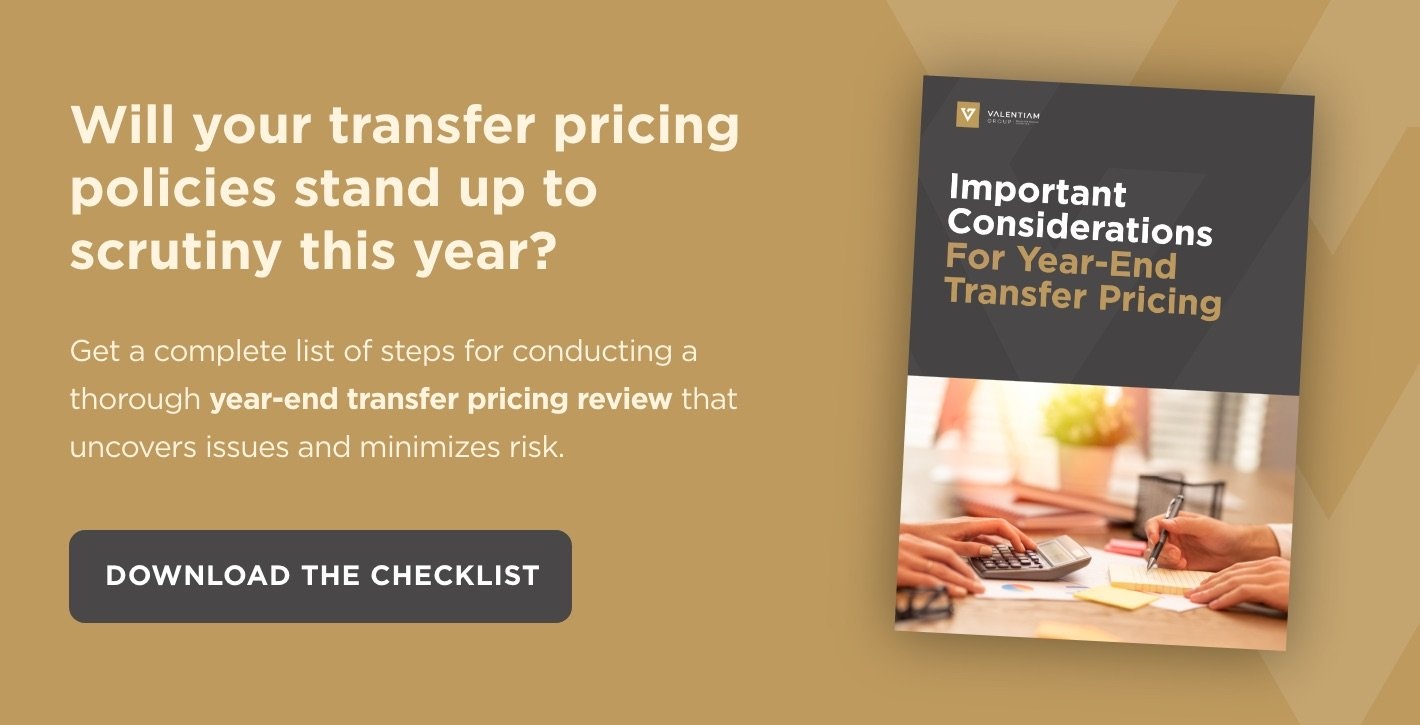Transfer Pricing Documentation: 5 Best Practices To Follow
Posted by Valentiam Group on December 5, 2019

Multinational companies face a serious burden when it comes to meeting their transfer pricing compliance requirements. It’s challenging (but, in most cases, essential) to produce contemporaneous transfer pricing documentation that complies with global filing requirements.
Transfer pricing documentation is required for a reason: It allows multinational organizations to demonstrate to the tax authorities in the jurisdictions where they operate that they’re compliant with local regulations. It also decreases the risk of potentially facing double taxation. Neglecting document preparation—or preparing documents incorrectly—could result in costly penalties, time-consuming disputes, and even litigation regarding whether transfer prices were set appropriately.
In this article, we’ll share some best practices for transfer pricing documentation with regard to meeting your requirements, coordinating with tax authorities, and using your internal resources wisely. By following these best practices, you can meet your compliance requirements and minimize audit risk.
5 Best Practices For Meeting Global Transfer Pricing Documentation Requirements
1. Be strategic about resource allocation.
Your company’s transfer pricing documentation is the starting point for reducing potential disputes with tax authorities and should be respected as such. However, it’s important to develop a strategy that allows your organization to ensure compliance and minimize tax obligations—without spending a ton of time and money in the process.
Companies are always faced with a decision on how much transfer pricing documentation to produce, as well as how much time and energy to invest in production. Small, non-controversial transactions, such as a cost plus service arrangement with a related party, shouldn’t require many resources annually. Once you've established prices for low risk transactions, the transfer pricing documentation should not require significant effort for these transactions.
2. Define the transfer pricing consultant role clearly.
Consultants play a critical role in transfer pricing compliance, but that role needs to be clearly defined to generate the best outcomes for your business. When you hire a transfer pricing consultant, you’re paying for their time. While that time is extremely valuable it’s best spent making strategic recommendations or resolving disputes—not sifting through finance records.
For example, sorting through your company's financial statements and segmenting data is not an area where transfer pricing consultants provide significant value. (Tweet this!) Almost any element of information gathering, which is necessary for transfer pricing documentation, can be done much more efficiently in-house by a member of your own team. When working with a consultant, be strategic about how they spend their time to encourage optimal results.
3. Align deliverables with tax authority expectations.
Another important best practice is to be open and honest with your local tax authorities to ensure the alignment of their expectations and your deliverables. While every company has certain reporting requirements to meet on an annual basis, it’s possible to work with the IRS or local tax authority to manage expectations moving forward.
For example, many companies reach an agreement with the IRS to only update routine intercompany transactions once every three years, and to set materiality thresholds as to which intercompany transactions will be documented. If you can come to an understanding with the IRS to manage expectations for your transfer pricing documentation requirements, both your reporting obligations and your audit risk will decrease.
Transfer pricing documentation is hard to manage alone. Talk to us about how our expert advisors can help you meet your compliance requirements.
4. Develop & maintain a concise, up-to-date master file.
It’s essential that your transfer pricing documentation format is clear to tax authorities, both on a high level and a more granular level for each local jurisdiction. Whether you’re striving to meet U.S., UK, or another jurisdiction’s transfer pricing documentation requirements, your company's master file should be concise and encompassing of all major transactions—while still being easy for tax authorities to review and comprehend.
Regularly update your master file to ensure it stays up-to-date and consistent with numerous local files. While you may not necessarily need to make big changes every year, you should at least be reviewing and cross-checking your documentation annually to be sure everything is accurate and aligned. There should be consistency in terminology, business and transaction descriptions, the roles of intercompany players, and any other significant details.
5. Be (sensibly) transparent in transfer pricing documentation.
Transparency is also a good best practice for transfer pricing documentation—but it has to be sensible transparency. Too often, transfer pricing documentation includes extraneous details and unnecessary analysis of the business and the market. Wordy transfer pricing documentation is potentially problematic, as the verbiage can be used against your organization by tax authorities.
Be open and transparent, but avoid commentary that is not required and may not be in your best interest. Every word in your reports should be carefully considered and included only if it's necessary for tax authorities to understand and properly audit your intercompany transactions.
Put Your Transfer Pricing Documentation In Expert Hands
Complying with transfer pricing documentation requirements can be extremely difficult—but doing so is essential to protect your business from potential disputes. If you’re tasked with global transfer pricing compliance—and overwhelmed as you try to navigate the process—let’s talk. At Valentiam, our advisors specialize in developing innovative solutions to transfer pricing documentation challenges. Schedule a call to learn more about our unique approach to transfer pricing compliance.
Topics: Transfer pricing
Related Posts
Fred Johnson Joins Valentiam Group as Partner and Dispute Resolution Practice Leader
We are pleased to announce the addition of Fred Johnson as a partner at Valentiam Group.
Dr. Stephen Blough Joins Valentiam Group as Partner
We are pleased to announce the addition of Dr. Stephen Blough as a partner in the firm.


